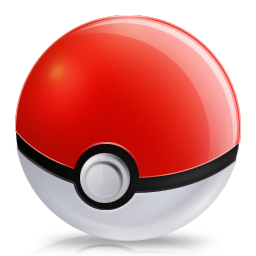



Our Recommended Packaging: Pokéball
 The formula for the volume of a sphere is
The formula for the volume of a sphere is  . After substituting 500 for the volume and solving for r, a radius of approximately
. After substituting 500 for the volume and solving for r, a radius of approximately 4.9237
is established. When this is put into the surface area formula, , it comes to
, it comes to 304.6443 cm2
. This is a significant savings over the "ideal" cylinder. Unlike the cylinder, for a given volume, there is only one possible radius and surface area.Since you need to think about larger quantities, the cost savings would be immense. In order to make a quality container, you would need to add .25 cm to the original radius for a true radius of
5.1737
. The volume of this container is580.0859 cm3
, so the volume of the packaging material is80.0859 cm3
. Since bulk manufacture is a key concern, we'll soon see how cost is affected in quantities of 1000 containers.To prove this point, the costs from three different materials will be put to the test. For this example, lets assume that 10,000 cm3 of rubber costs $133.64, aluminum costs $137.98, and glass costs $149.49. 80,085.9359 cm3 of each material would be needed. This comes to $1070.27, $1105.03, $1197.20 respectively.
Since each ball holds 500 cm3 of tomato sauce, 500,000 cm3 of sauce is needed for 1000 jars.
You'll need something like 3500 tomatoes ($399.99), 40 pounds of various spices ($249.99), and various amounts of salt, preservatives, and other ingredients ($359.99). A total of $1009.97 is spent on the sauce.
If the sauce is packaged in rubber, it will cost $2080.24 (cost of materials and sauce combined. For aluminum, it would be $2115 and for glass it would cost $2207.17. This translates to a cost of manufacture of $2.08, $2.12, and $2.21, respectively.
From here, we would sell the product to stores at $3.50 each, which leaves them room for markup and profit. For the IRS, the profit for 1000 containers would be $1419.76 for rubber, $1385 for aluminum, and $1292.83 for glass.
In comparison, using the same process, the cylinder would need 92.3496 cm3 of material per container. This is 92,349.5939 cm3 of material for 1000 containers, an increase of 12,263.6579 cm3 (15.3%). Even being generous and using rubber, the cost per 1000 comes to $2244.13. This is $2.24 each to manufacture and profit of $1255.87 per 1000 containers sold to stores.